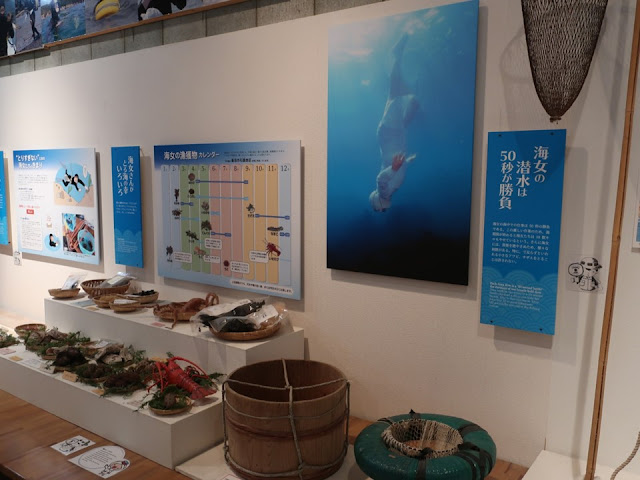Toba is in Mie prefecture of central Japan. It has Ise Shrine which
is dedicated to Amaterasu (a deity who is considered as the ancestor of the
royal family). The region is rich in marine resources.
The huge museum shows us the regional fishing culture and industry
well. I divided into three parts below.
伊勢・志摩の漁とその生活がよく分かる巨大博物館です。次の三つのパートに分けて、紹介します。
There are eight building including three exhibition halls.
敷地には3棟の展示施設(体育館のような形です)を含めて、8棟の建物があります。
At the entrance of the main exhibition hall (Hall A), a doll of an ama diver welcomes us. She (Matsumura Mume) was an actual diver; her model is the one when she was seventy-five years old. The banner on the left shows how deep they can dive. The depth of a dive is from ten to twenty meters when they had a weight. On the other hand, it is around eight meters without the weight.
メインの展示棟に入ると松村むめさん(当時75歳)をモデルにした海女さんが迎えてくれます。青い垂れ幕は、重りを持った海女さんが10~20mまで潜りますということを実寸で示しています。ちなみに、重りを持たない海女さんが潜れるのは、8mぐらいまでとのことでした。
There are a museum shop and a spot for your commemorative photo there. I saw the video of ama next.
左側がミュージアムショップと記念撮影スポット。続いて海女さんのビデオを拝見しました。
Ama divers spend time in their hut after fishing. They warm themselves using fire and enjoy chatting. I’m sure it’s a fun time; women are good at chatting.
ビデオでは、海女さんが潜った後、海女小屋で暖をとりながらおしゃべりする様子が映っていました、楽しみだと思います。女性はおしゃべりが得意ですからねえ。
The poster above announced “Ama summit in 2011”. I wonder what they discussed?
海女さんのイベントのポスターが貼られています。サミットがあったのですねえ。
There is Ama Section in the Hall B.
展示B棟の一階には、「志摩の海女」のコーナーがあります。
There are two kinds of ama divers. “Funa-do” is the way of a couple’s dive fishing; “Funa” means a boat and “Do” means a person. A wife dives into with a weight which depth is from ten to twenty meters. Her husband is on the boat and pulls the rope and so on. It is also called a pop-and-mom boat.
On the other hand, in “Kachi-do”, a woman swims with a wooden tub.
She dives to the depth of five to eight meters without a weight. She keeps her
catches in the tub.
カチド(徒人)では、桶につかまりながら泳いでいき、5~8m潜って漁をします。一方、フナド(舟人)では、重りを使って潜水し、10~20m潜ります。船上の夫が綱を引き上げるなど夫婦共同の作業です。「トトカカ舟」ともいわれるそうです。
“Each dive is a ‘50-second battle’ – the duration of one breath-hold dive. ---Ama lose 10 or more kilograms by the end of the fishing season.”, it says. It’s a hard work.
海女さんの潜水は50秒。漁期が終わると十数キロ痩せるそうです。
The scraper above was used to catch an abalone. It is heavy more than I thought. They remove it off very carefully even while holding their breath, because a damaged one is not worth. It’s painstaking but profitable (a big one worth more than $100).
海女さんが使うアワビオコシ、意外と重かったです。息を止めての作業ですが、傷が付くと売り物にならないので、素早く、かつ、丁寧にとります。たいへんだけど、お金になりますね。
There total number of ama across Japan in 2010 was 2,174; 660 of them were in the region (Shima Peninsula). However, there were 12,426 ama divers in 1931, so it decreased to one sixth. The tools below the panels are scrapers for abalone in various areas.
2010年の海女さんの数は2174人、そのうち660人が志摩半島にいます。1931年の海女さんの数は12,426人、1/6ぐらいになりました。意外だったのは、能登の海女さん。167人(1931年)→176人(1978年)→197人(2010年)、と増えています。
手前に並べられているのは、“アワビオコシ”。日本各地で大きさも形も違います。
Ama divers’ personal equipment、海女の装い
Ama had dived without a shirt, but wore white diving outfit which became standard wear in the early 20th century. In around 1955, they began “to use wet suits to improve their performance”.
上半身裸で潜っていましたが、大正頃から白い磯着を付けるようになりました。昭和30年代からは防寒性が高いウエットスーツになりました。
I don’t know which area it was, however, there is a photo of ama without a shirt. It was taken in 1908. (Travel views of Japan and Korea: https://www.loc.gov/pictures/collection/agc/item/2018719429/resource/)
地域はわかりませんが、こういう写真が残っています。1908(明治41)年の写真です。
Their faces are shining even they are on the land. Everyone looks strong and tough.
潜っていなくても良いお顔をしていますね。皆さんたくましそう。
Ama’s hut、海女小屋
The hut above was rebuilt based on advices of ama (upper right). Such a hut had been used until around 1965. Ama brought material and built a hut with pals in April. After fishing, they rinsed themselves by water, went into the hut and warmed themselves. They chatted loudly, and slept after getting warm. They took rest like that.
右上の海女さんたちが、1965年頃まで使っていた海女小屋の再現です。毎年4月頃、気のあった海女仲間が材料を持ち寄ってつくりました。海から上がると水をかぶって潮を落とし、小屋に入って火にあたって暖をとりました。大声でおしゃべりをし、体が温まると昼寝などをして体を休めたということです。
It is written, “the time Ama spend in their hut, resting and chatting together, is precious.” That’s right. Ama are diligent and busy; they are engaged in not only fishing but also farming and housework.
海女は働き者、家事に野良仕事に海女漁。「海女小屋でのだんらんのひと時ほどくつろいだ楽しい時間はない」と書かれています。でしょうね。
Common talismans of Ama’s equipment Seiman and Doman、魔除けの印(セーマンとドーマン)
It says, “These protect Ama from danger and strange phenomena”.
魔除け。潜水中に海女たちは魔物に出くわすことがあるという。そのために、セーマン、ドーマンという魔除けの印を身につける。セーマンは安倍晴明、ドーマンは蘆屋道満に由来するともいわれている。
(1) Women has enough fat beneath the skin which keep them warm even in the seawater.
(2) Men work at offshore, so women work at coastal area.
(3) The role to catch an abalone and to offer to deities or a dynasty was a job of women.
①皮下脂肪が多く、寒さに耐えられる
②男は沖の仕事が増え、磯の仕事は女が増えた
③神や朝廷へアワビを奉る役割は斎宮のように女性の役割であった
「海士」と書いてアマと呼ぶ地域もあります。これは男性です。
The phots above are at the section which theme is “Ama pray to the gods of the sea”. It is written, “These divers never neglect the rituals and customs of asking for not only a big catch, but also for protection from misfortune, knowing full well that the sea can nourish many lives, as well as take them away in instant.”
「海女、海人に祈る」というテーマで展示されています。「海女たちは豊漁や災厄防除などの海人に祈る儀礼・習慣をおろそかにしない。海は多くの生命を育み、時にそれらを一瞬にして奪うことを知っているからだ」と書かれています。
Official website: http://www.umihaku.com/english/index.html
http://www.umihaku.com/ (in Japanese), accessed in September,
2023
Visited in
March, 2023
Previous post (museum at the neighboring prefecture, Aichi): Akasaka post-town
and Toyokawa Inari Shrine、赤坂宿・御油の松並木・豊川稲荷
Next post (part2 of this museum, Fishers’ life,
prayer and festivals/漁民の暮らしと祈り・祭り): Toba Sea-Folk
Museum (2/3)、鳥羽市立海の博物館 (part2)


















Comments
Post a Comment